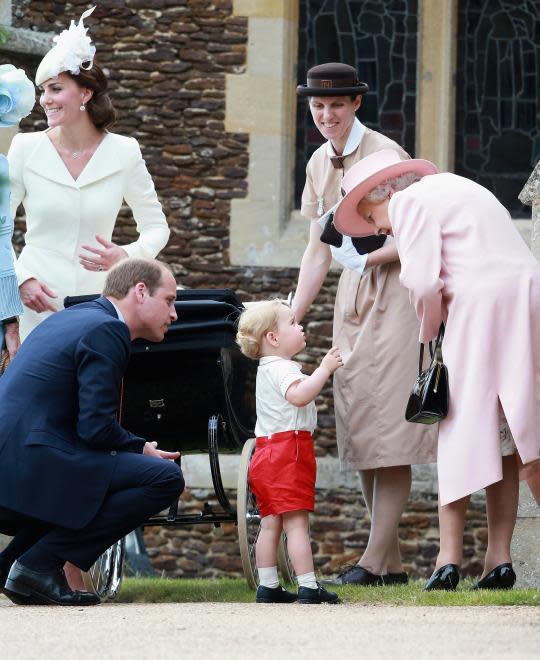Kate Middleton Ends Four-Month Maternity Leave

Kate Middleton is reportedly ending a four-month maternity leave after the birth of Princess Charlotte to focus on her work duties. (Photo: Getty Images)
It’s back to work for Kate Middleton, who is reportedly wrapping up a four-month maternity leave this week with plans to attend the Rugby World Cup and a children’s charity event.
Middleton, who gave birth to daughter Princess Charlotte on May 2, is making good on a promise she made in April: to take a longer maternity leave than she did after the birth of Prince George in July 2013. (That time, only one month postpartum, the duchess made a public appearance at an athletic event, then attended a ball with Prince William a few weeks later.)
“She felt she came back too soon last time,” a royal source told People. “She wants to have that [family] and enjoy it with George and the new baby.”
STORY: White House: Why All Families Need Paid Leave
And while Middleton has hit various royal functions since giving birth to her daughter, “It’s unlikely she’ll resume a full-time work schedule,” CNN royal expert Victoria Arbiter tells Yahoo Parenting. “She’s not working a 9-to-5 job, so she’ll keep commitments within reason. It will be great to see her back out there, but her focus is still very much on the children. I doubt we’ll see a lot of her between now and December.”
STORY: Replaced While on Maternity Leave: What’s Legal, What’s Not?
To help care for their two children, Prince William and Kate Middleton employ Maria Borrallo, who has worked for the couple since George was born. Barrallo studied at Borland College in Bath, dubbed “the Mary Poppins” school for its comprehensive training — students learn defensive driving and security protocol — and its reputation for churning out “perfect nannies.” The royal couple also hired a maternity nurse when George was a newborn, despite reported attempts to initially forgo one.

Kate Middleton and Prince William’s nanny Maria Borrallo cares for Princess Charlotte and Prince Harry. Here, she’s pictured with the royal family at Princess Charlotte’s christening in July. (Photo: Getty Images)
In the U.K., mothers are entitled to 52 weeks of leave (divided into “ordinary” leave and “additional” leave) with 39 of those weeks paid. Fathers had been entitled to one or two weeks of paid leave (or up to 26 weeks of paid additional leave if the mother returned to work), however, a new law now allows couples to divvy up those weeks between them.
The United States is the only developed country to not offer mandatory paid family leave and, according to the Washington Post, annual childcare costs are higher than college tuition rates. That means many working families are resorting to one-income salaries so one spouse can provide childcare; many couples are choosing to not have children at all. (On Monday, though, President Obama provided new hope in this arena with a new executive order giving workers with federal contracts up to seven days of paid sick leave each year.)
Employees of the British Monarchy receive maternity, paternity, and adoption leave, along with fertility treatment leave, and childcare vouchers. But royal parents, even with enormous public obligations, play by their own rules.
Diana, Princess of Wales, was committed to parenting with work-life balance. While pregnant with William at age 20, she regularly fulfilled her royal duties, despite experiencing morning sickness (though not as severe as Middleton’s hyperemesis gravidarum, reports ABC News). What’s more, Diana brought baby William on a royal tour because she didn’t want to separate from him or stop breastfeeding, which royal expert Kate Coyne said was “unheard of” in the family at the time. And while Lady Di and Prince Charles hired a nanny named Olga Powell when Prince William was six months old (she also cared for Prince Harry), Diana wanted her children to have a somewhat normal childhood, having them wait in line at department stores to visit Santa Claus and even doing school drop-offs before starting her workday.

Nanny Olga Powell caring for a young Prince Charles and Prince Harry at a polo match in Windsor, England. (Photo: Tim Graham/Getty Images)
Will and Kate seem to have taken a cue from the late princess, adopting an equally progressive stance. For example, the prince attended the births of both of his children (unlike his father Prince Charles when William and Harry were born) and took advantage of his two-week paternity leave on both occasions. And when Prince George was only eight months old, his parents combined work and family by taking him on a tour to New Zealand and Australia. Middleton has also been photographed carving out quality time with Prince George on playdates.
And while the royals have resources and flexibility that other families may not, William and Kate are clearly conveying that families everywhere should be afforded work-life balance. And that’s an attitude that can’t hurt the royal couple, either — especially if new rumors that they’re now planning on a third child prove to be true.
Please follow @YahooParenting on Facebook, Twitter, Instagram, and Pinterest. Have an interesting story to share about your family? Email us at YParenting (at) Yahoo.com.

